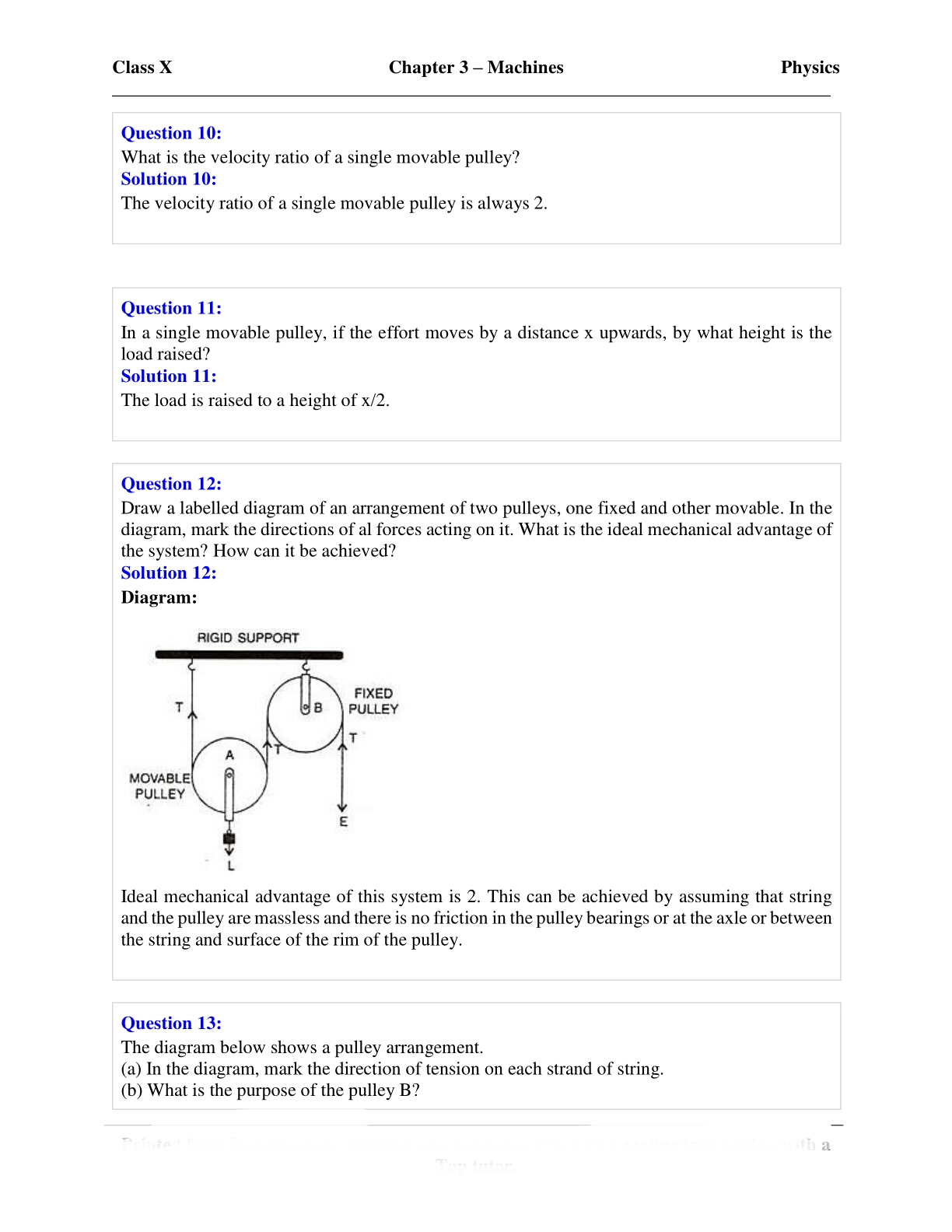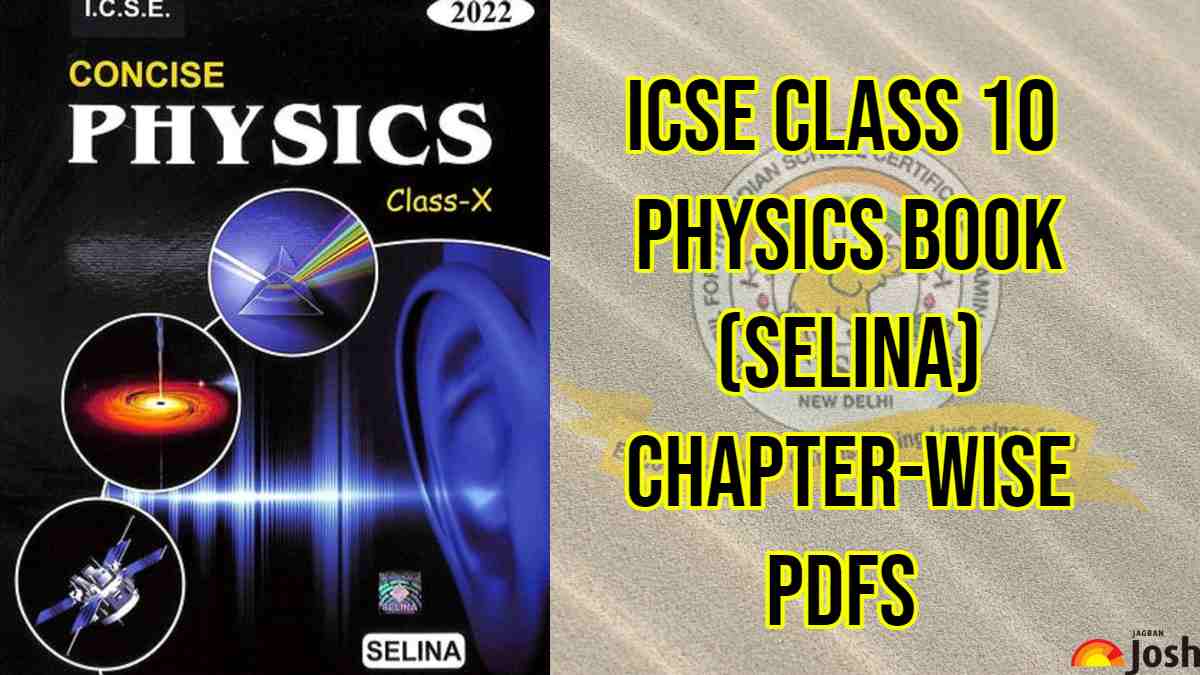
Concise Physics Class 10 ICSE Solutions Chapter 3 Machine ICSE HUB
Solution 3. The ray of light which is incident normally on a plane glass slab passes undeviated. That is such a ray suffers no bending at the surface because here the angle of incidence is 0°. Thus if angle of incidence ∠i = 0°, then the angle of refraction ∠r = 0°. And the angle of deviation of the ray will also be 0°.

Selina Solutions Concise Physics Class 10 Chapter 1 Force Free PDF
The ICSE Class 10th Physics Selina Concise Solutions contains 12 chapters of the prescribed current syllabus in ICSE Physics Class 10th textbooks. We provides ICSE Class 10 Physics Formula Chapter-Wise students to help them and score well in the Council examination.

Concise Physics ICSE Class10 Solutions Selina Publishers ICSEHELP
The four pulleys can be used as three movable pulleys with one fixed pulley as shown in the diagram below: Assumptions are —. (i) The weight of the pulleys and the string is massless. (ii) There is no friction between the bearings of the pulley. Get solutions of ICSE Class 10 Concise Physics Selina Chapter 3: Machines.

Selina Solutions Concise Physics Class 10 Chapter 1 Force Free PDF
Solution 6. (i) Perpendicular distance of point A from the force F=10 N at B is 0.5m , while it is zero from the force F=10N at A. Hence, moment of force about A is. = 10 N x 0.5m=5Nm (clockwise) (ii) Perpendicular distance of point B from the force F=10 N at A is 0.5m, while it is zero from the force F=10N at B.

Selina Solutions Concise Physics Class 10 Chapter 7 Sound access free PDF
Answer. (a) 1 g ice at 0° C requires more heat to raise it's temperature to 10° C. (b) 1 g ice at 0° C requires more heat to raise it's temperature to 10° C because 1 g ice at 0° C first absorbs 336 J heat to convert into 1 g water at 0° C and then the water absorbs heat to raise it's temperature from 0° to 10° C.

Selina Solutions Concise Physics Class 10 Chapter 5 Refraction through a Lens Get free PDF
Class 10 Selina Physics is a book with concise Physics syllabus. The book's language is clear with appropriate examples to help the students learn Physics concepts easily. As per the.

Selina Solutions Concise Physics Class 10 Chapter 3 Machines Avail PDF (2022)
Chapter 1 - Force Chapter 2 - Work, Energy and Power Chapter 3 - Machines Chapter 4 - Refraction of Light at Plane Surfaces Chapter 5 - Refraction through a Lens Chapter 6 - Spectrum Chapter 7 - Sound Chapter 8 - Current Electricity Chapter 9 - Household Circuits Chapter 10 - Electro-Magnetism Chapter 11 - Calorimetry Solutions OLYMPIAD FOUNDATION

Selina Solutions Concise Physics Class 10 Chapter 2 Work, Energy and Power Access free pdf
Using Selina Concise Physics Class 10 ICSE solutions Calorimetry exercise by students is an easy way to prepare for the exams, as they involve solutions arranged chapter-wise and also page-wise. The questions involved in Selina Solutions are essential questions that can be asked in the final exam. Maximum CISCE Concise Physics Class 10 ICSE.

ICSE Selina Concise Physics Book for Class 10 Download the Chapterwise Free PDFs and Solutions
Chapter 1 of Selina Solutions Concise Physics Class 10 deals with the study of Force. Force applied on a body is defined as the rate of change in its linear momentum. A rigid body when acted upon by a force, can have two kinds of motion i.e., linear or translational motion and rotational motion.

Selina Solutions Class 10 ConciseSelina Solutions Concise Physics Class 10 Chapter 10 Electro
Class 10 - Concise Physics Selina Exercise 12 (A) Question 1 Name the three constituents of an atom and state mass and charge of each. How are they distributed in an atom? Answer The three constituents of an atom are electrons, protons and neutrons. The mass of an electron is 9.1 × 10-31 kg and charge is -1.6 × 10-19 C.

Download Oswal CBSE Class 10 Concise Physics PDF Online 2020
Answer. (a) When force acts at an angle θ to the direction of displacement then work done is. W = F × S Cos θ. (b) (i) For work done to be zero the angle between force and displacement should be equal to 90° as cos 90° = 0. Therefore, product will also be zero. W = F × S Cos 90°. = 0.

Selina Solutions Concise Physics Class 10 Chapter 8 Current Electricity Get PDF Here
Solution 3. (a) When force is at an angle θ to the direction of displacement, then work done, W= F S cos θ. (b) (i) For zero work done, the angle between force and displacement should be 90 o as cos 90 o = 0. W = FS cos90 o = FS x 0 = 0. (ii) For maximum work done, the angle between force and displacement should be 0 o as cos0 o = 1.

Selina Solutions Concise Physics Class 10 Chapter 2 Work, Energy and Power Access free pdf
Our Selina Concise Physics ICSE Class 10 Solutions cover chapters such as force, spectrum, household circuits, sound etc. These Physics solutions help you to remember the correct answers and understand the concepts quickly.

Selina Solutions Concise Physics Class 10 Chapter 1 Force Free PDF (2022)
(a) Name and state the law which relates the potential difference and current in a conductor. (b) What is the necessary condition for a conductor to obey the law named above in part (a)? (a) The law which relates the potential difference and current in a conductor is known as Ohm's law

Selina Solutions Concise Physics Class 10 Chapter 8 Current Electricity Get PDF Here
Class 10 - Concise Physics Selina Selina Solutions Concise Physics Class 10 ICSE ICSE Class 10 Physics 2022-23 Syllabus Chapters Chapter 1 Force Chapter 2 Work, Energy and Power Chapter 3 Machines Chapter 4 Refraction of Light at Plane Surfaces Chapter 5 Refraction Through a Lens Chapter 6 Spectrum Chapter 7 Sound Chapter 8 Current Electricity

Selina Solutions Concise Physics Class 10 Chapter 3 Machines Avail PDF
Selina Solutions Concise Physics Class 10 are helpful for students who want to perform well in the exam. Students can download the Selina Solutions PDF from the links given below Download PDF of Selina Solutions Concise Physics Chapter 4 Refraction of Light at Plane Surfaces